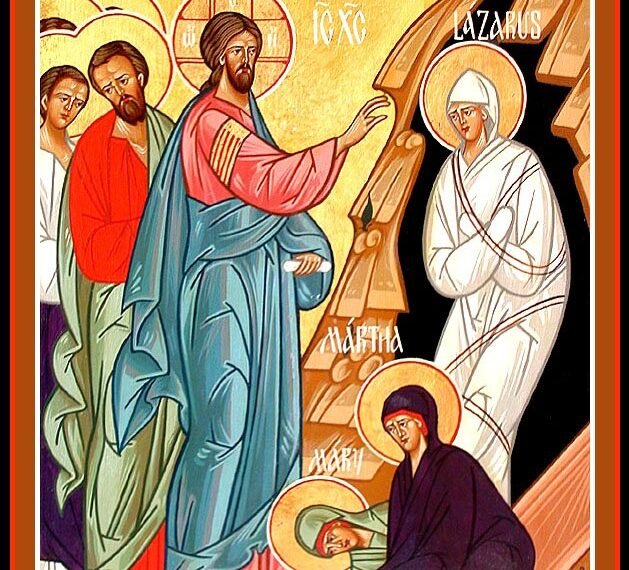Contenus
ToggleIn short
Le samedi de Lazare dans le christianisme oriental (composé des Églises orthodoxe orientale et orthodoxe orientale ) fait référence à la fête mobile avant le dimanche des Rameaux auquel il est liturgiquement lié. Elle célèbre la résurrection de Lazare de Béthanie. Béthanie est enregistrée dans le Nouveau Testament comme un petit village de Judée, la maison des frères et sœurs Marie de Béthanie, Marthe et Lazare, ainsi que celle de Simon le lépreux.

Samedi de Lazare puis dimanche des Rameaux
L’évangile de Jean rapporte que « Six jours avant la Pâque, Jésus vint à Béthanie, où vivait Lazare, que Jésus avait ressuscité des morts. » Vraisemblablement, c’est là qu’il a passé le Grand Sabbat qui se produit immédiatement avant la Pâque, avant son entrée triomphale à Jérusalem. On rapporte que Jésus y a logé pendant la semaine sainte, et c’est là que son onction par la sœur de Lazare, Marie, a eu lieu quelques jours plus tard le mercredi saint.
Au cours de la semaine précédente, les propres du Triode de Carême suivent la maladie puis la mort de Lazare, et le voyage du Christ d’au-delà du Jourdain à Béthanie. Cette semaine est appelée la « semaine des palmiers » ou la « semaine fleurie ».
Ayant accompli les quarante jours qui profitent à notre âme, nous te supplions dans ton amour pour l’homme : accorde-nous aussi de voir la semaine sainte de ta passion, afin que nous puissions glorifier en elle tes actes puissants et ton ineffable dispensation pour nous, chantant d’un même esprit : Ô Seigneur, gloire à Toi.
Pendant les vêpres du vendredi, la lecture de la Genèse (qui a commencé le premier jour du Grand Carême) se conclut par la description de la mort, de l’enterrement et du deuil de Jacob (Genèse 49 :33-50 :26) et le vendredi soir, à la complie, un Canon sur la résurrection de Lazare par saint André de Crète est chanté ; c’est un canon complet rare, ayant les neuf cantiques.
Les lectures des Écritures et les hymnes de ce jour se concentrent sur la résurrection de Lazare comme préfiguration de la résurrection du Christ et préfiguration de la résurrection générale. Le récit de l’Évangile est interprété dans les hymnes comme illustrant les deux natures du Christ : son humanité en demandant :
« Où l’avez-vous mis ? (Jean 11:34), et sa divinité en ordonnant à Lazare de sortir d’entre les morts (Jean 11:43). Un certain nombre d’hymnes, écrits à la première ou à la deuxième personne, relient symboliquement la mort, la mise au tombeau et les liens d’inhumation de Lazare à l’état pécheur de l’individu. De nombreux hymnes de résurrection du service normal du dimanche sont chantés tandis que les prières pour les défunts, prescrites le dimanche, sont autorisées.
Au cours de la liturgie divine, l’hymne baptismal, « Tous ceux qui ont été baptisés en Christ ont revêtu Christ » (Romains 6:3) remplace le Trisagion indiquant que cela avait été un jour où les baptêmes étaient pratiqués [4] et dans certains les églises de nos jours, les convertis adultes sont encore baptisés ce jour-là.
Bien que les quarante jours du Grand Carême se terminent le vendredi de Lazare, ce jour est toujours observé comme un jour de jeûne ; cependant, le jeûne est atténué pour permettre la consommation de caviar, les œufs étant un symbole de la résurrection et proéminents sur Pâques, et les œufs de poisson en étant une ombre montrent la résurrection de Lazare comme une préfiguration de la résurrection du Christ, comme expliqué dans les propres du journée.
Le samedi de Lazare est le jour où, traditionnellement, les ermites quittaient leurs retraites dans le désert pour retourner au monastère pour les offices de la Semaine Sainte. Dans de nombreux endroits de l’Église russe, les vêtements et les tentures de l’église ce jour-là et le dimanche des Rameaux sont verts, indiquant le renouveau de la vie. Dans l’Église Greek, il est de coutume le samedi de Lazare de tresser des croix élaborées à partir de feuilles de palmier qui seront utilisées le dimanche des Rameaux.
Social networks
celebrate Lazarus Saturday. It refers to the resurrection of Lazarus, friend of Jesus, and marks the end of Great Lent. The feast, combined with Palm Sunday, precedes Holy Week. It is considered an anticipation of Easter and the mystery of the Resurrection. #mythology #myth #legend #calendar #orthodox #lazare
Picture
